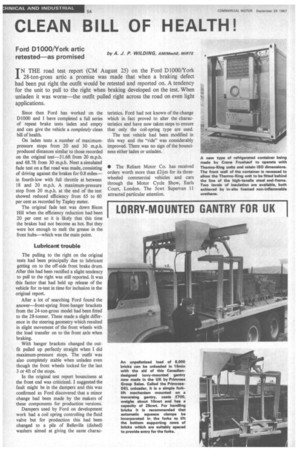CLEAN BILL OF HEALTH!
Page 56

If you've noticed an error in this article please click here to report it so we can fix it.
Ford 01000/York artic retested—as promised
by A. J. P. WILDING, AMIMechE, MIRTE
TN THE road test report (CM August 25) on the Ford D1000/York 28-ton-gross attic a promise was made that when a braking defect had been put right the outfit would be retested and reported on. A tendency for the unit to pull to the right when braking developed on the test. When unladen it was worse—the outfit pulled right across the road on even light applications.
Since then Ford has worked on the D1000 and I have completed a full series of repeat brake tests laden and empty and can give the vehicle a completely clean bill of health.
On laden tests a number of maximumpressure stops from 20 and 30 m.p.h. produced distances similar to those recorded on the original test-31.6ft from 20 m.p.h. and 68.7ft from 30 m.p.h. Next a simulated fade test on a flat road was made, consisting of driving against the brakes for 0.8 mites— in fourth-low with full throttle at between 18 and 20 m.p.h. A maximum-pressure stop from 20 m.p.h. at the end of the test showed reduced efficiency from 65 to 60 per cent as recorded by Tapley meter.
The original fade test was down Bison Hill when the efficiency reduction had been 20 per cent so it is likely that this time the brakes had not become as hot. But they were hot enough to melt the grease in the front hubs—which was the main point.
Lubricant trouble
The pulling to the right on the original tests had been principally due to lubricant getting on to the off-side front brake drum. After this had been rectified a slight tendency to pull to the right was still reported. It was this factor that had held up release of the vehicle for re-test in time for inclusion in the original report.
After a lot of searching Ford found the answer—front-spring front-hanger brackets from the 24-ton-gross model had been fitted to the 28-tonner. These made a slight difference in the steering geometry which resulted in slight movement of the front wheels with the load transfer on to the front axle when braking.
With hanger brackets changed the outfit pulled up perfectly straight when I did maximum-pressure stops. The outfit was also completely stable when unladen even though the front wheels locked for the last 3 or 4ft of the stops.
In the original test report bounciness at the front end was criticized. I suggested the fault might be in the dampers and this was confirmed as Ford discovered that a minor change had been made by the makers of these components for production versions.
Dampers used by Ford on development work had a coil spring controlling the fluid valve but for production this had been changed to a pile of Belleville (dished) washers aimed at giving the same charac teristics. Ford had not known of the change which in fact proved to alter the characteristics and have now taken steps to ensure that only the coil-spring type are used.
The test vehicle had been modified in this way and the "ride" was considerably improved. There was no sign of the bouneiness either laden or unladen.
• The Reliant Motor Co. has received orders worth more than aim for its threewheeled commercial vehicles and cars through the Motor Cycle Show, Earls Court, London. The 5cwt Supervan 11 attracted particular attention.




































































































































































